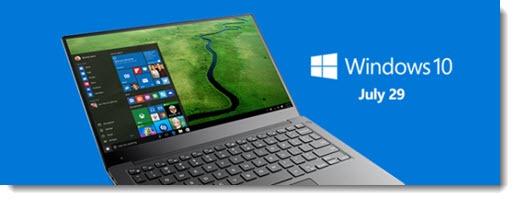
Windows 10 will be released on July 29. You should look forward to it. It’s all good news. Microsoft has been working to combine the best features of Windows 7 and Windows 8 into a single new operating system. There is every reason to hope that Windows 10 will be the best version of Windows ever released.
Free upgrade
Windows 10 is a free upgrade for every computer running a licensed copy of Windows 7 and Windows 8.1. Many of you have already seen a Windows 10 upgrade icon appear in the lower right of your screen, urging you to “reserve” a copy of Windows 10. It’s not really a reservation; it allows your computer to download the installation files for Windows 10 ahead of time so there’s no delay when you decide to upgrade.
Free. No strings, no charges later. You really can upgrade your computer to Windows 10 for free. The free upgrade will be available for one year. If you haven’t upgraded by July 28, 2016, you’ll have to pay for a license.
New features in Windows 10
There are no big surprises or unintuitive pieces in Windows 10. Microsoft learned its lesson with Windows 8, which had an unexpected Start screen and many elements off-screen where they were not easily discoverable. Over the last three years, many things have been brought into view as Windows 8.1 has developed – onscreen buttons for power, for logging off, for search, for accessing the list of all programs, for minimizing and closing full-screen apps, and more. Windows 10 furthers the goal of making Windows easier to use and more transparent, and returns a few things from Windows 7 that people missed. It feels familiar but there are design changes throughout to make it easier to know what to do next.
Improved performance Engineers have been working hard to deliver faster startup times and improved performance, especially compared to Windows 7. It will speed up older computers. It will only be an incremental improvement – your four year old computer with a Core i3 processor won’t turn into a racecar – but Windows 10 will help.
New for Windows 8 users If you’re used to Windows 8, then Windows 10 will look like a natural evolution of familiar elements. The Start screen returns to being a menu, as it should have been all along. The modern apps that only run full-screen in Windows 8 will now be able to run in windows on your desktop like all the other programs in Windows 10. The web browser is named “Microsoft Edge” instead of Internet Explorer, but the name was chosen in part so it can have a familiar looking “E” icon. (Microsoft created a new web browser for better security and compatibility, hoping to make up lost ground against Google Chrome.)
New for Windows 7 users There will be more adjustments for Windows 7 users but I don’t expect much of it to be jarring or unwelcome. There’s a ribbon in File Explorer, similar to the Office programs. The process of copying and moving files has big visual improvements, as well as better performance under the hood. Task Manager has been rewritten – at once simpler and more powerful. Windows Backup has been supplemented with File History, which is even better for day-to-day backup of documents, pictures, and music. (Windows Backup was completely removed from Windows 8 but is being returned to Windows 10, so Windows 7 users can continue to use their familiar backup program if they choose.)
Brand new features There are some brand new features in Windows 10. Cortana is a digital assistant that plugs into Windows Search and handles natural language queries (“show photos from April”), and also answers questions and suggests relevant info like Apple Siri and Google Now. Continuum works on hybrid devices like Microsoft Surface and Lenovo Yoga Pro 2 to switch between laptop and tablet appropriate settings automatically when the keyboard is engaged or disengaged. There’s an improved Task View that shows all open windows at once, and a new feature to switch among multiple virtual desktops. Windows Hello will improve support for using a fingerprint to unlock the computer; eventually facial recognition will unlock the computer as soon as we sit down, but only after we buy new computers with updated cameras.
The design is modern and clean. More settings have been moved from Control Panel to a vastly simplified Settings menu. Much work has been done to make programs consistent and to make it easy to use them on screens of all sizes.
There are a few caveats. As always, line-of-business programs may be slow to support Windows 10, so businesses will have to investigate the programs they depend on before approving the upgrade. I have some reservations about whether you’ll like the Start menu (“cluttered mess” was the term I used), but it will be easy to customize or replace with Start10.
Some of you are quite happy, thanks, and don’t want anything to change on your computers. You know who you are. There’s no pressure. Keep using Windows 7 with my blessings.
Most of you, though, will find Windows 10 to be a natural upgrade and maybe even enjoyable to use. Fingers crossed, but I don’t see the same rough edges that will lead to a backlash when you sit down at a Windows 10 computer.

Is there anything else?
So that’s it! Good times ahead.
Well, there is one more thing.
Under no circumstances do I want any of you to upgrade to Windows 10 when it becomes available. Absolutely not. No way. Stare at the upgrade message like it’s poison.
I’ll tell you that story in the next article.

OUT OF YOUR BLEEDING MIND BEST EVER!!! PURE JUNK!!!! CROOKS!!! THIEVES!!! DESERVED TO BE KICKED IN NUTS THEN SPAT ON!!!!!!!!!! MOTHER FUUUUCKERS!!!!!!!!!!!!!!!!!!!!!!!!!!!!!!!!!!!!!!!!!!!!!!!!!!!!!!!!!!!!!!!!!!!!!!!!!!!!!!!!!!!!!!!!!!!!!!!!!!!!!!!!!!!!!!!!!!!!!!!!!!!!!!!!!!!!!!!!!!!!!!!!!!!!!!!!!!!!!!